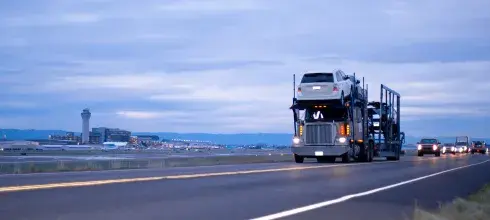Have you ever thought about where your local dealer gets their cars from? There’s nothing like a dealer fairy that gets them there by magic. In reality, the process is a little more complicated. The dealer-to-dealer car shipping process involves several different partners along the way and requires a great deal of planning and consideration to protect the precious cargos that could potentially be worth hundreds of thousands of dollars.
How did dealer-to-dealer shipping work in the past?
It might feel like cars have been around forever but they’re quite a recent invention. The original version of a car was patented in 1886 and since then, they’ve come a long way.
The car originally came from Europe, which meant it had to be shipped over the sea. As soon as cars became more popular manufacturing started in the US which meant cars were shipped to dealers by rail.
At the time, this was a very expensive undertaking and a long-winded process because of the limited rail infrastructure. These issues led a man called Alexander Winton to invent the first auto carrier way back in 1898.
The first auto carrier was nothing like the ones you see today. It was a car that had two wheels at the back and a flatbed on top. However, this wasn’t the best solution because it could move just one car at a time.
Rail transport continued to be the primary method of shipping cars across the US for many years. Although, some innovations made it a more effective mode of transportation. For example, in the 1950s, a two-level vehicle-carrying rail car was invented. Within a decade, there was also a tri-level vehicle carrying rail cars.
Around the same time, road auto transport methods were also being developed, and along came auto carriers that looked very similar to the ones used today. These carriers were far more efficient and could transport up to eight cars simultaneously.
How dealer-to-dealer shipping works today
Nowadays, things are done differently, although it is similar in some ways. To begin with, a considerable percentage of vehicles bought in the US are imported. In 2017, the annual figure was 8 million units. Although, in 2020, US imports dropped to 6.5 million units.
Cars imported from overseas have to take multiple modes of transportation. The start of their journey will be by cargo ship. These specially built ships can hold up to 8,000 vehicles and have multiple decks for maximum capacity. The ships are also designed to allow cars to simply roll on and roll off.
The vehicles arrive in several different ports, the main ones being Los Angeles, Long Beach, New York, Savannah, Seattle, Houston, Charleston, Miami, and Norfolk. Once they arrive at a port, they are rolled off and then stored until additional transportation is available.
While rail transport is still commonly used, the other mode of transportation is with a truck.
Auto transport services across country
When it comes to shipping cars by road, open trailers are the most common way it’s done. The trailers are open on all sides and tend to be double-deckers. In other words, up to 10 cars can be transported simultaneously.
If you ever get to watch cars being loaded onto an open trailer, it looks a little like a game of Tetris. This is because the carrier wants to maximize the number of vehicles they fit onto a single trailer in one shipment.
Drivers play an important part in the auto transport process
Transport drivers are a key part of the car shipping process and they do much more than drive the vehicles on and off the trailer and then drive between pick-up and delivery locations. They also have to make sure every car is secure and keep them safe throughout the journey. The average price of a new car is around $40,000 so at any given moment, they’re hauling hundreds of thousands of dollars worth of merchandise.
Drivers are required to meet a certain level of experience, hold certain qualifications, and pass certain exams. The most important is the commercial driver’s license or CDL. To obtain a CDL, a person must be 21 years old or over, complete an application, pay a fee, provide proof of identity, and provide proof of residency. In addition, they must submit a medical examination, pass a vision test, and pass a knowledge exam. Finally, they must pass a driving examination and road skills test.
Holders of a CDL license are not automatically allowed to transport vehicles. Companies transporting such high-value cargo look for drivers with the most experience, the best qualifications, and a clean safety record.
Official transportation rules
Car shipping companies have to follow guidelines when hauling vehicles from a manufacturer to a dealership. In addition, there are federal regulations all commercial drivers must follow.
Cargo weight
According to federal regulations, the weight of a tractor, trailer, and cargo cannot exceed 80,000 pounds. These rules apply to 40-foot and 20-foot trailers with a tri-axle. If the trailer is only 20 feet, the maximum weight is 70,000 pounds.
There are also state regulations that apply. Most states limit the weight to 20,000 pounds for single-axle trailers, 34,000 pounds for double-axle vehicles, and 42,000 pounds for trident-axle trailers.
Trailer vehicle weight and height
There are no federal regulations concerning height, however, many states impose their own restrictions. Generally, the height limit is between 13 feet, six inches, and 14 feet.
Most carriers tend to impose their own restrictions. Typically, this would be seven feet for vehicles they’re willing to transport.
Driving hours
For safety reasons, the federal government sets limits on the number of hours a driver can spend on the road. These Hours of Service, or HOS, are to reduce fatigue and promote driver safety.
Drivers who are transporting property, such as vehicles, are allowed to drive up to 11 driving hours per day. There is also a limit of 14 hours for the time they are on duty. When a driver has been driving for eight consecutive hours, they must take a 30-minute break.
When a driver has been on duty for 7-8 consecutive days, they must not drive after 60-70 hours.
Can I get a dealer to ship a car to me?
Yes, it is possible to get a car shipped by a dealer which is great news if you’ve found your dream car in a dealership in another state.
When you ask a dealer to ship a car to you, there will be two options: open car shipping and enclosed auto transport.
Open car transport means your car is shipped in a trailer that’s open on all sides. The trailers tend to have two levels, so the number of cars transported is maximized. Open transport is the cheapest option, but it does come with a greater risk of damage from the elements and road debris.
Choose enclosed auto transport and your car is placed on a trailer that’s completely enclosed on all sides. This type of trailer is typically smaller, so only one or two vehicles can be shipped at the same time. Enclosed auto transport tends to cost around 30% to 40% more.
Can a dealer ship a car to a different city?
There is no problem for a dealer to ship a car to a different city. It might be to another dealer or a person’s home. Whichever is required, the process is the same. The following steps apply:
- Choose a car shipping company
- Select your shipping method
- Coordinate between dealership and shipping company
- Schedule a drop-off date.
Can a dealer have a car shipped to them?
It’s perfectly feasible for a dealer to arrange for a car to be shipped to them. Auto transport services are available for individuals and businesses, whatever the business is.
Cost to ship a car from a dealer
More and more people are purchasing their vehicles and searching farther than ever before for the perfect ride. Gone are the days of being restricted to a local dealer. Now you can do your car shopping online and check the virtual lot of dealerships all over the country.
However, one thing that has to be factored in when buying a car across the country is the cost of car transportation.
Like any product or service, it pays to compare shops before you make your final decision. Comparing prices is a very easy thing to do because the best auto transport companies all offer free-no-obligation shipping quotes.
To get a quote, you have to provide some basic information such as:
- The car make and model
- Distance
- Its running condition
- Type of service
- Preferred shipping date
If you want to know how much it will cost to ship a car with SGT Auto Transport, get your quote today.
Cost to ship a car to another dealer
If you find a car you like at one location and want to have it brought to a more convenient location, it’s possible to get a car shipped to another dealer. Dealerships are generally more than willing to work with each other to help a customer.
How much it will cost depends on several factors. These factors are the same whether you’re shipping to your home, between dealers, or to another location.
If you want to talk to a real person about your car shipping needs, our shipping advisers will help you. You can reach them at (864) 546-5038 or via Live Chat.
FAQs
How do dealers ship cars?
Open car transport is generally the preferred option for dealerships that need to ship cars. This form of auto transport is cheaper and more cars can be shipped simultaneously. Enclosed car shipping tends to be reserved for expensive or rare cars.
What is dealer-to-dealer car shipping?
Dealer-to-dealer car shipping is a way for dealers to move their inventory efficiently and easily from one location to another. It’s a good option because it doesn’t add any extra mileage to the vehicles.
How long does it take to ship a car from dealer to dealer?
How long it takes for a car to be shipped from one dealer to another depends on several factors. These include the distance the car has to travel, the location of the dealerships, the time of year, and road and traffic conditions.
How do you ship a car between dealerships?
The most common way to ship a car between dealerships is with open car transport. Enclosed auto transport is another option, but this costs more.
Can a dealership get a car from another dealership?
Yes, a dealership can easily get a car from another dealership using auto transport services.






